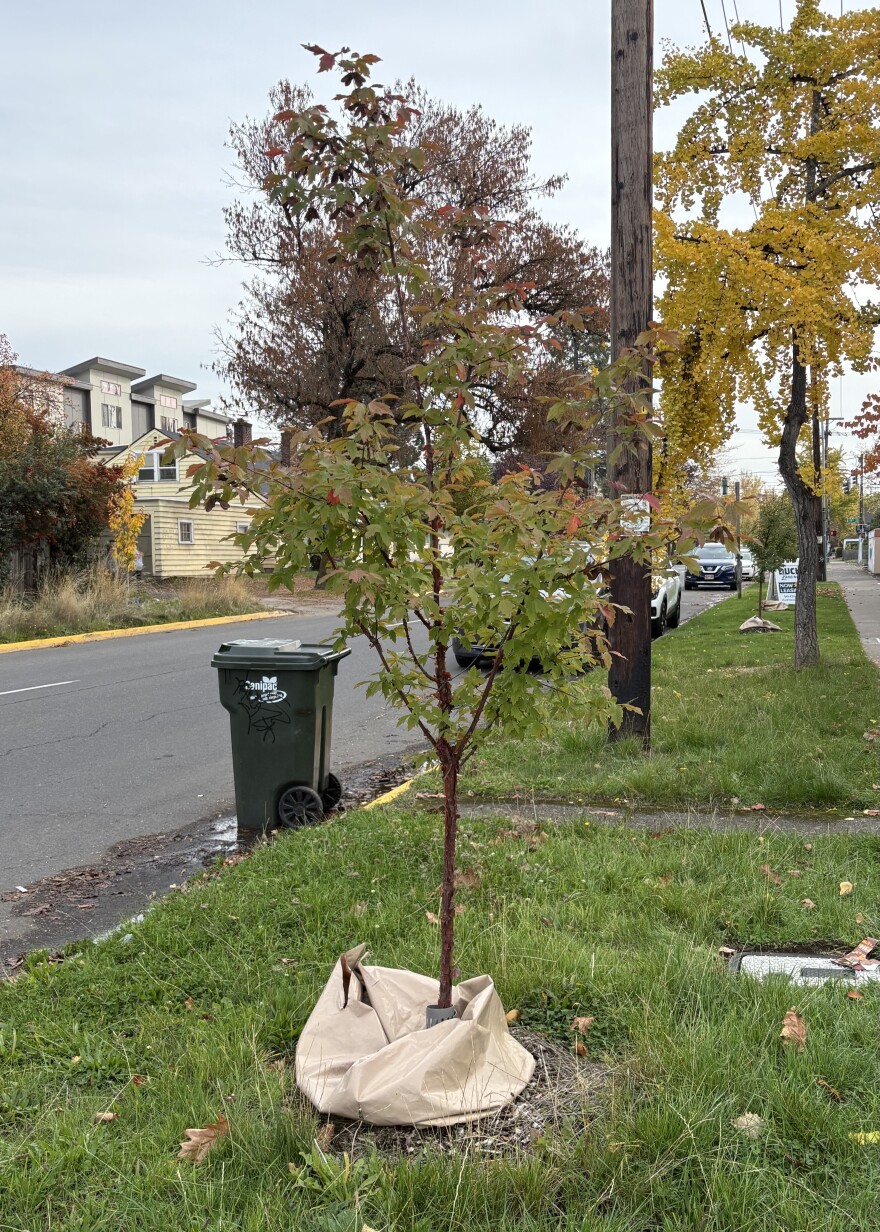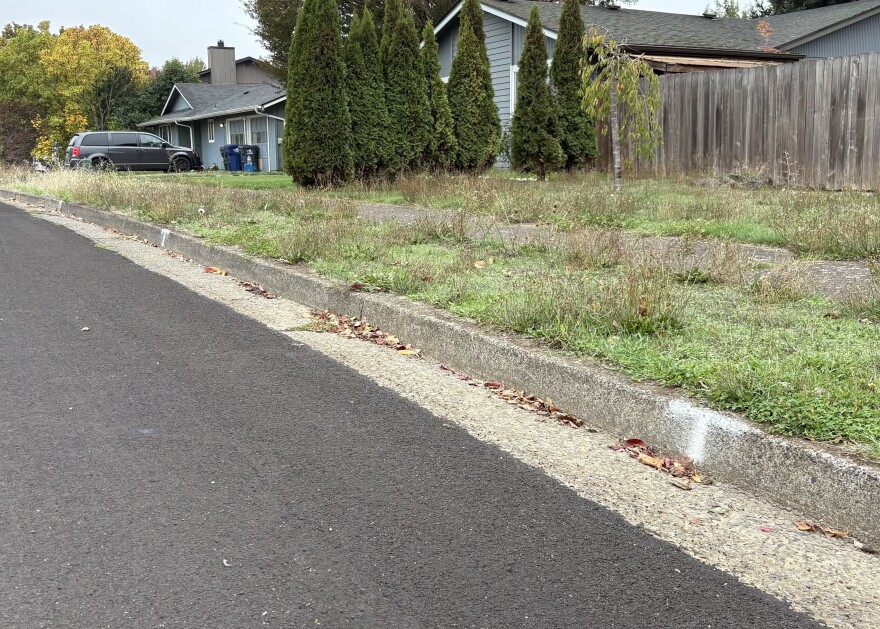Along the streets of Eugene, trees of various shapes and sizes create canopies of green, orange and red. Whether they sit on the side of the road, on medians or in the center of a roundabout, most of these trees were planted by Eugene’s Urban Forestry Department.
The department manages more than 75,000 public street trees, planting and maintaining them throughout each year.
This year, the City of Eugene created its first Urban Forest Action Plan update in more than 35 years.
“That really outlines for the public, for the stakeholders, for the community, what our program is doing and why we're doing it,” said Spencer Crawford, a supervisor and forester for the Urban Forestry Department. “We're trying to meet the needs of servicing the community as best we can, to keep the trees healthy and active and vibrant, as well as plant and establish where canopy coverage is low.”
Guided by one of the city’s climate action goals of 30% canopy coverage by 2040, the team will aim to plant 3,000 trees on street rights-of-way each year. The city currently has about 23% coverage.
More trees in urban areas have been shown to have significant environmental benefits. High canopy coverage can mitigate the effects of climate change, improve air and water quality, regulate temperatures so homeowners can spend less on heating and cooling, and create habitats for wildlife.
City, state and federal funding will support the project, including grants from the Oregon Department of Forestry and funding from the U.S. Environmental Protection Agency.
Crawford said the federal funding is allocated for the next three years, and the Urban Forestry Department does not expect to lose the funding due to cuts or the continued government shutdown.

“We're trying to get that work done as soon as possible, in case funding were to somehow be retracted,” he said. “But there's no indication that's happening yet.”
The work for this year’s round of tree planting has already begun.
Using a geographic information mapping system, the Urban Forestry team created an inventory of every tree already existing on street rights-of-way. That map is also being used to evaluate which areas need more trees.
“With that updated inventory, we're able to go in and do a bunch of on-site planning efforts and realize where there are gaps in existing canopy street trees and where the opportunity is highest,” Crawford said. “We're trying to focus on areas of the city where there are the fewest trees right now, where the right of way space for planting is the largest, so that we can establish large, healthy trees, so that they'll be able to give back.”
The focus on areas with low coverage ties into what the Urban Forestry Department calls “Tree Equity.” Using this term as a framework, the department has assigned neighborhoods a tree equity score out of 100.
It may seem like there’s no shortage of trees in Eugene – and western Oregon as a whole. Parts of Eugene have up to 67% coverage and a tree equity score of 100.
But in some neighborhoods, like areas that were historically flat or farmland, canopy coverage can be as low as 9% with a tree equity score of 57.
One of those locations is the Bethel neighborhood in northwest Eugene. During a drive through the area, Urban Forestry Department Arborist Eric Mullin pointed out multiple residential blocks that are being prepared for planting down the line.
Where there are rights-of-way big enough for tree planting, he’s marked white T’s on the curb.
But Mullin said the team is not randomly planting trees on these streets. Street location, tree sizes and property nearby need to be taken into account.
“Just between one side of the street and the other, you could have vastly different conditions. And then that being the urban environment, the built environment,” Mullin said, “this is all artificial. So whatever native soils had been here aren't necessarily the topsoils that are left.”

Arborists like Mullin also have to consider the width and depth of rights-of-way so that tree roots do not interfere with curbs or property. The height of trees planted can vary depending on traffic patterns and telephone poles.
Sometimes, personal safety of the arborists can be at risk, Mullin said.
“On Highway 99, I had to mark out some spaces for this year, for trees that we lost in the median from vehicle access this past year,” Mullin said. “It's nerve wracking not knowing what traffic is going to do, and just how frequently we see vehicle accidents out there. A lot of times there's no guarantees when you're out there, you try to make yourself as visible as possible.”
And planting in residential areas comes with its own set of challenges.
Some homeowners may not realize that their property often does not extend to the sidewalk of their street. If they build a fence past their true property line, they encroach on the right-of-way space where trees could be planted.
“That fence that's behind us, they just may not have realized that their property actually ended here, or maybe it could be the lack of city presence for so long that people just kind of naturally take over that space,” Mullin said. “On the other side of the street, you can see, it appears that their neighbors have built their fences where the property line is. So you're just walking around on the street and vetting.”
In order for the 30% goal to be reached, Crawford said there will have to be partnership with the community. Most of the trees that contribute to high canopy coverage areas are on private land.
But residents can help. If there is potential to plant trees on personal property, the Urban Forestry Department offers planting permits and advice on which trees to plant, where to plant them and how to maintain them.
Crawford said tree planting is about the tangible environmental benefits, as well as the betterment of city aesthetics and community well-being.
“Sometimes we take trees for granted. Right now, in the fall, if you've been walking around the city at all and seeing all the fall change and the leaves, you might have also felt a bunch of inspiration in that space,” Crawford said. “We're trying to bring a bit of that nature into the city and have it impact us in our daily lives and, as people who care for this resource on a daily basis, our work is focused on helping people see and experience that value in a real, tangible way.”






